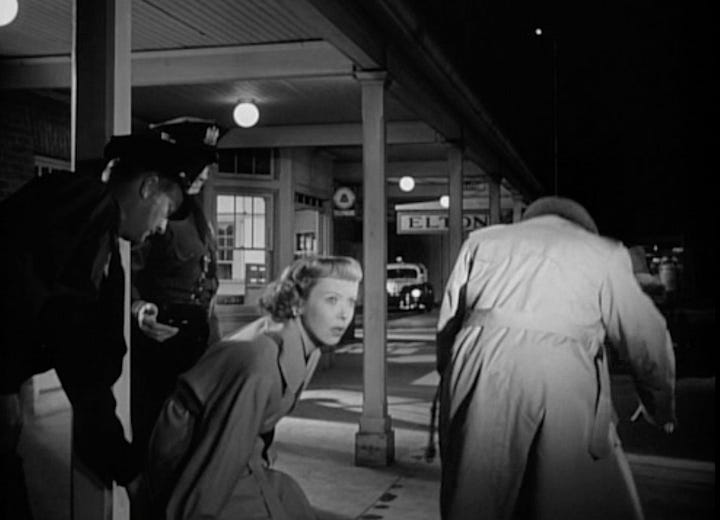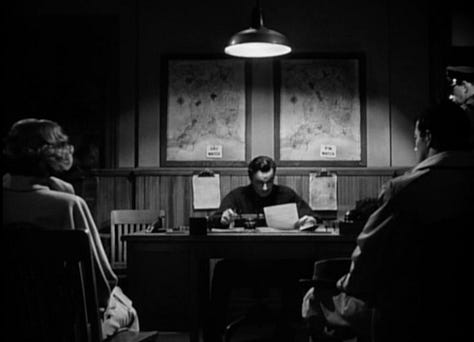Five of our favourite shots from 1948 noir Road House.
What A Big Knife You Have
At this point in the film Jefty (Richard Widmark) has backed Lily (Ida Lupino) and Pete (Cornel Wilde) into a corner, and is threatening to put Pete in jail if they don’t do everything he asks.
This entire three-minute scene runs in this frame and is never boring, because 1. director Jean Negulesco knew how utterly compelling his leads are 2. prominent in the bottom-middle of frame, and flashing in the bright lights, is a knife Lily is using to make sandwiches.
A knife at least quadruple the size and sharpness needed for sandwich making.
The scene is so tense partly because the take never cuts, and partly because that knife is just so convenient. If only Lily twisted a few inches and plunged it . . .
Smoke and Lanes
Fifteen seconds of Ida Lupino glowering, smoking, and putting on her jacket.
The lanes are all lit, pins in the background standing ominous in their dark caves. Triangles of light on the wall break the shot into thirds. Lupino is blocked so her white shorts pop against the bowling ball return, her sweater ‘breaks up’ the outfit so we’re drawn to her face even before she smokes, and puts on her white jacket like a matador donning a cape (what a choice!)
The scene crossfades right into the next; a technique Road House uses quite often — in fact our next three scenes all meld together this way.
Closeup to Wide in a Camera Move
We get a shot of the letter Pete’s writing (which holds before he signs long enough to read the whole text), then the camera moves out to a gorgeously shadowy wide shot
It stays on this wide as Pete goes to the safe, fiddles with an envelope, then leaves.
The shot is broken up with an insert of the envelope Pete puts in the safe (which details become important later), thus events on either side of the envelope closeup may be from different takes, but all of these frames are from the same shot.




Hold on a Wide
Like our opening shot, the train scene holds on a wide, with just one adjustment: moving up slightly as Lily stands (0:22).
But where our opening shot is about the simmering tension of three people crowing a frame, and the tension of a conspicuous knife, this is wholly different.




This shot is about stark lighting, timing, the way Lily’s smoke hangs in the air and Pete’s face moves in and out of shadows as he talks, how the platform columns frame the approaching cops.
Everything here is lit and blocked so we never need a closeup.
Live Lighting
When the ‘train’ comes — 45-seconds into this 55-second shot — it’s not going to be dependent on a real train. Someone — more likely, multiple someones — are just off-screen moving big heavy lights around to get this effect.
Road House uses live lighting shifts in others scenes as well, as when Jefty brings Lily breakfast in bed as a pretext to assume intimacy, and opens her curtains.
Though the lights outside the curtain are on, there’s off-screen choreography involved here too — you can see other lights being turned on in time with the actor opening the curtains, because the scene needs significant front and top light as well.
Why does it need this flood of light? The better for us to clearly see how everything plays out, down to every facial expression and eye shift.
Cop Shop Blocking
The first two scenes were essentially an ‘invisible’ oner and a still-frame oner, but this scene has several cuts, and continues long after we ended the clip.
It’s still worth noting how the camera moves and creates frames-within-frames and significant moments via blocking: how we see Lily though the door before the cop opens it; how the ‘head honcho’ is framed with symmetry, including when Lily and Pete sit on either side of him.



There’s quite a light on the note he holds up to incriminate Pete (third shot, above).
It’s note we saw in closeup less than five minutes ago and so clearly know what it is even without an insert shot in this scene.
Takeaways
The crossfading between those last three scenes helps drive home how close together all these events and scenes are, even as their events and blocking and lighting are all quite different.
All the rest is delicious, high-contrast, dramatic noir.




